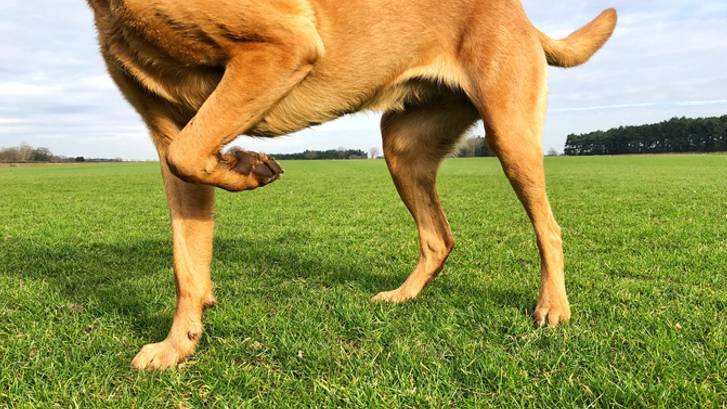Joint pain in dogs: How to help with arthritis and other disorders
Joint pain in dogs is a common complaint. Read on as Dr. Rebecca MacMillan explores the various causes and treatment options

Joint pain in dogs is a common ailment but that doesn’t make it any less serious. Indeed, dogs suffering with arthritis and other disorders can end up leading restricted lives and seeking treatment could help to relieve the symptoms.
Luckily, a lot of research has gone into the diagnosis and management of chronic joint pain in dogs. It means there is greater awareness of the causes, which go beyond age-related arthritis in dogs, and more treatment options, too.
So let’s take a look at what you can do to relieve joint pain in dogs with the aid of expert vet Dr Rebecca MacMillan. She also discusses the right time to say goodbye if a dog’s condition is affecting their quality of life.
Types of joint pain in dogs
There are four main causes of joint pain in dogs, as follows:
Hereditary
A hereditary condition describes something that an animal is born with like spinal deformities or joint dysplasia. Both hip dysplasia in dogs and elbow dysplasia are seen in some pups more than others, with large breeds like Labrador Retrievers and German Shepherds being most affected.
The joint doesn’t develop properly in affected animals. This means the bones do not fit together perfectly causing abnormal rubbing and friction. This creates pain and inflammation in the joint and can lead to secondary changes like arthritis. The joint may also be more lax than normal causing the dog to be weak when exercising.
Acquired condition (trauma or contagious illness)
Joint pain can sometimes occur through an acquired condition like a fractured bone or a cranial cruciate ligament injury, or an illness like a tick-borne disease.
Ticks are blood-sucking parasites that can attach to your pet’s skin to feed on their blood. Ticks can carry harmful bacteria and blood parasites in their saliva and the longer it is attached the more likely the tick will transmit disease to your dog.
Making sure you know how to remove a tick from your pet as soon as you see it is advised, or even better, ensure your pet has regular tick treatments to reduce the risk of them biting in the first place.
Autoimmune
Autoimmune disease occurs when the body starts attacking its own cells, leading to pain and inflammation. Examples that affect joints include Immune-mediated polyarthritis (IMPA) and steroid-responsive meningitis arteritis.
Age-related
Also known as degenerative joint disease, this develops as an animal ages. General wear and tear can cause joints to become sore, as well as specific age-related diseases such as osteoarthritis (referred to as just arthritis by many) and cancer.
According to one study published in Scientific Reports, osteoarthritis is the most diagnosed joint condition in veterinary practices. It can occur secondary to joint malformations (like hip and elbow dysplasia) or joint injuries (like cruciate ligament disease). But in some cases, there is no primary cause other than age and wear, though it is more commonly seen in overweight animals.
Symptoms of joint pain in dogs

The most symptoms of joint pain are as follows:
- Lameness could be continuous or intermittent
- Stiffness, especially after resting
- Pain, crying out
- Sleeping more
- More grumpy than usual
- Difficulty exercising or jumping up
- Fever may be seen in animals with autoimmune or tick-borne disease
Treating joint pain in dogs
Knowing which treatment to pursue depends on the underlying cause of your dog’s joint pain. In many cases, it’s a matter of knowing how to choose the best pain relief for dogs. In most cases, a non-steroidal anti-inflammatory will be used.
These drugs provide pain relief but also help with inflammation. They can be used for short-term issues as well as longer-term complaints. Other painkillers that may be used in conjunction with these, which your vet can advise you on.
Infectious diseases or infections within joints will usually benefit from antibiotic treatment. Some conditions such as cruciate ligament injury or spinal disorders may do best with surgical intervention.
In many cases, complementary therapies such as hydrotherapy and physiotherapy can be effective at helping to build muscle mass and to gently exercise stiff joints.
You’ll need a prescription, but you can buy Rimadyl chewable tablets for your dog via Chewy. The active ingredient is carprofen, which is often used to treat arthritis.
What are the first signs of arthritis in dogs?
Most owners notice intermittent lameness or stiffness, especially after the dog has been resting. Some dogs may start to ‘slow down’ and not be quite so keen to exercise too.
What age do dogs get arthritis?
The age at which dogs get arthritis is very variable! Larger breeds or overweight dogs will tend to suffer earlier than smaller dogs. But if your dog has an underlying joint abnormality like hip dysplasia then he may develop arthritis much sooner than a normal dog.
What can I give my dog for arthritis?
Speak to your vet about treatment options for arthritis. You can give your dog joint supplements at home, but many will also benefit from prescription medications for dogs like non-steroidal anti-inflammatories.
How to help a dog with arthritis and other joint pain disorders

It’s worth becoming familiar with ways to cope with arthritis in dogs. As you will see, joint supplements for dogs are useful because they can maintain healthy joints, slow the progression of joint damage and improve mobility.
You should also ensure your dog is keeping to a lean, fit weight so learn what to do if your dog is overweight to prevent excessive pressure being put on diseased joints. The best dog food will help, but some animals may benefit from a specific weight loss regime.
Try and help your pet by lifting them in and out of the car, or providing a ramp, if they are struggling to jump. Buying one of the best orthopedic dog beds is also a good idea.
When to consider euthanasia
Sadly, there are some circumstances where, despite everyone’s best efforts, your dog’s quality of life may be starting to suffer. To try and assess this, ask yourself the following questions: Are they still enjoying life? Are they still able to do the things that they like doing best? Are they having more bad days than good? Euthanasia may be the kindest option for some animals.
It might also be considered when owner finances prevent certain treatment options from being available. If an animal requires surgery or long-term medication, but an owner cannot afford this, then euthanasia will prevent suffering.
This is a tough call, but a realistic one especially as some incurable or long-term cases can be quite a financial strain on families. Of course, other avenues can be explored such as charity help or finance options, but these might not be available to everyone.
Joint pain can have many underlying causes in dogs, but the most common is osteoarthritis. Your vet will be able to help diagnose your dog’s joint complaint and suggest appropriate treatment to make them more comfortable. Don’t delay, earlier intervention leads to better outcomes and an improved quality of life for your pet!
PetsRadar Newsletter
Get the best advice, tips and top tech for your beloved Pets
Rebecca is a veterinary surgeon who graduated in 2009 from the Royal Veterinary College in London. She has a wealth of experience in first opinion small animal practice, having done a mixture of day-to-day routine work, on-call emergency duties and managerial roles over the years. Rebecca enjoys medicine in particular and she is proud to have recently achieved a BSAVA postgraduate certificate in small animal medicine (with commendation).
She writes on various feline and canine topics, including behavior, nutrition, and health. Outside of work and writing she enjoys walking her own dog, spending time with her young family and baking!


